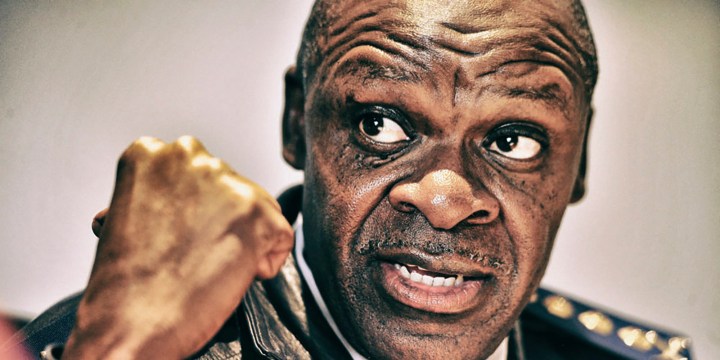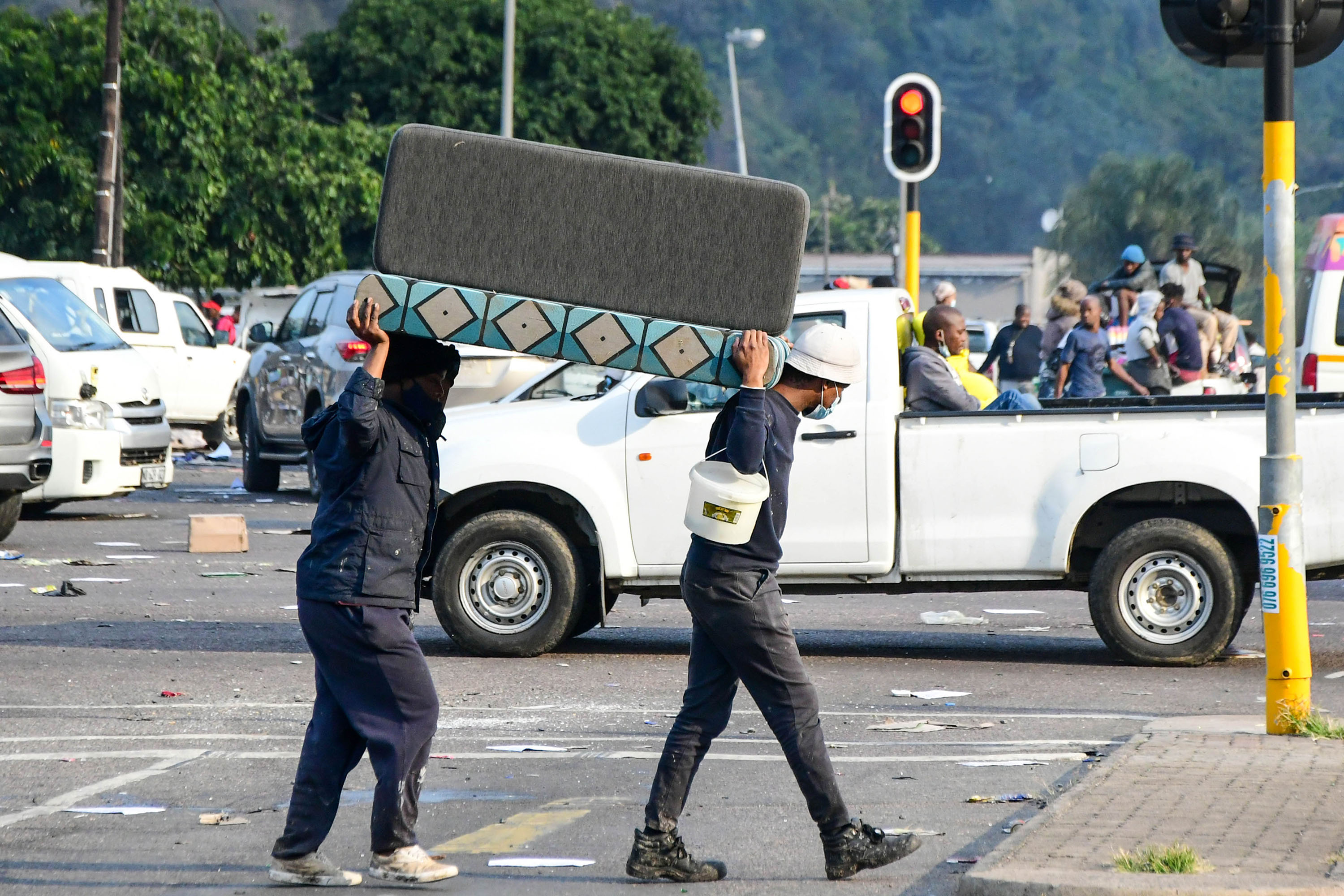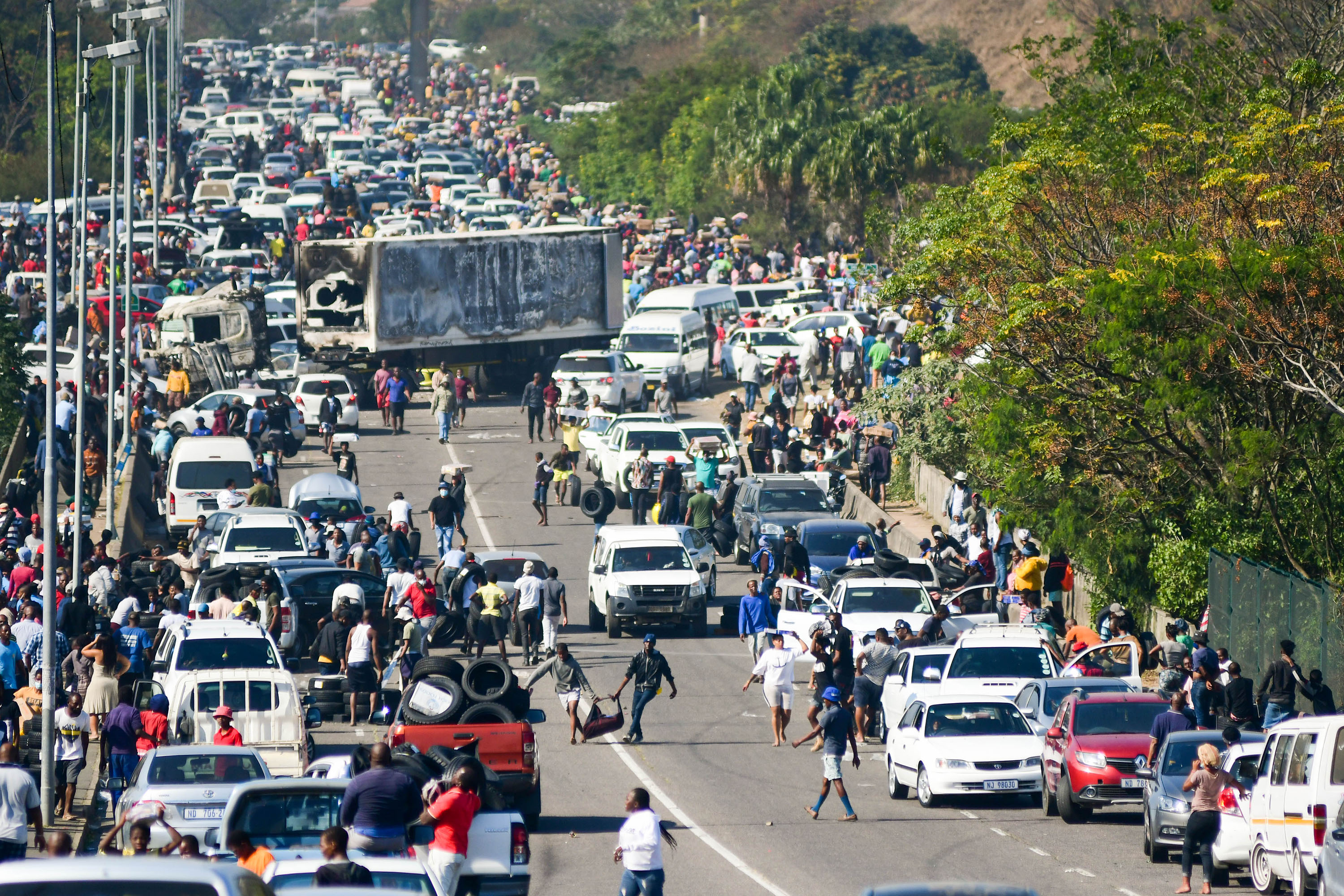JULY RIOTS
Outmanned, outgunned, outrun: Police commissioner Sitole admits SAPS’ failings as SAHRC hearings continue

Officers of the South African Police Service were not ‘equal to the task’ when riots and looting broke out in KwaZulu-Natal and Gauteng, in July, the South African Human Rights Commission heard on Monday.
National police commissioner General Khehla John Sitole was giving testimony to the commission’s investigations into the violence via a video link from Turkey, where he is attending an Interpol conference.
The SAHRC heard that there was a shortage of human resources to deal with the thousands of looters that had taken to the streets, and that a “new” modus operandi — including the use of technology, presumably instigation via social media — made planning for interventions difficult.
“The July unrest, from what we have experienced, it was a planned gathering with an unpredicted modus operandi. The planners first invented a new modus operandi, thereafter they executed it.
“It was the first modus operandi of its kind — the first unrest that started directly at level 3 (level one being the lowest for public unrest). Level 1 and 2 capacity was already written off when [the unrest] started. Evidence gathered proves that it was planned.”
Sitole was unable to give the commission the number of deaths recorded as a result of the riots. However, at a parliamentary briefing just after the unrest, police minister Bheki Cele said the number of deaths stood at 359.
This number, however, is subject to adjustment.

Looters packing their BMW with furniture in Springfield on July 13, 2021 in Durban, South Africa. (Photo by Gallo Images/Darren Stewart)
Sitole told the commission that many inquests were still being investigated. Last week, the commission heard from one witness claiming he had initially been recorded as having died during the unrest during alleged racially determined revenge attacks in the eThekwini suburb of Phoenix.
The vast majority of the killings took place in KwaZulu-Natal and were as a result of looters being crushed in the frenzy for stolen goods, or fighting with each other over the same goods, according to premier Sihle Zikalala at the time. Zikalala is expected to testify before the commission in the coming days.
The SAHRC started its hearings into the unrest last week, with testimony from affected community members kickstarting proceedings. Later in the week, CEOs from the Pietermaritzburg and Durban chambers of business gave evidence about the effect the destruction had on their members.
SAPS has been severely criticised and accused of being largely absent during the eight days of rampant criminality, which cost KwaZulu-Natal at least R20-billion, with the eThekwini metro shouldering the brunt of the destruction.
Investor confidence was hammered during and after the unrest, with various corporations and businesses saying the ability of the police to protect property and citizens was a serious deterrent to investment.
Sitole said the new modus operandi of the protestors and presumably their instigators “was that of overstretching the police resources”.
“They would start something at a particular hotspot area, when that was stabilised, they would start at another. They were drawing us to a human capital crisis. There was a need for deployment of capital resources — Nyalas, water cannons. Members also had to be flown in, I called all supporting role players.”

Looters carrying loot in Umgeni Road on July 13, 2021 in Durban, South Africa. (Photo by Gallo Images/Darren Stewart)
He told the commission that there had never been an order issued for SAPS to stand down during the unrest. It was Pietermaritzburg and Midlands business chamber CEO Melanie Veness who told the commission last week that this was what she had heard from police officers, although she was not privy to who had given the alleged order.
Said Sitole: “The instruction I gave was that all resources of SAPS must be deployed and a written instruction was [issued]. No other instruction would have been given contrary to this…it would have amounted to misconduct.”
The unrest started with the jailing of former president Jacob Zuma on a contempt of court charge (Zuma has since been released on medical parole). Supporters of the former president had gathered at his Nkandla homestead to ensure that he was not jailed, and from that venue, and via social media platforms, threats were expressed freely about how the country would pay the price in the form of protests if Zuma was incarcerated.
After hours of “negotiations”, Zuma eventually handed himself over to police at his homestead and was rushed through to the Estcourt Correctional Centre in the early hours of 8 July. That night, sporadic reports of unrest and trucks being looted and torched — not uncommon in KwaZulu-Natal — were being received by journalists, and presumably by police.
Sitole said that from the time the Constitutional Court issued its directive that Zuma should be jailed, police were ready and had an operational plan in place. It was the unprecedented scale of the violence and the change in modus operandi that they were not ready for, he admitted.
“The unrest started with the execution of [the constitutional] court order, there was a fully-fledged operational plan. There was an early warning that was issued without specifics, and national instruction three was issued by the deputy commissioner for contingency alertness. Contingency planning instructions are always there, but because the modus operandi was not exactly known, there wasn’t an approved operational plan. But there was contingency alertness.”
SAPS’s human capital was severely strained even before the unrest, said Sitole, a result of restructuring. The service’s Public Order Policing (PoPs) was understaffed, he admitted. Currently, there are 5,005 members nationwide, with the ideal number being 12,000.
Every police station in the country had level 1 and two PoP units, he said. Level 3 units were always on standby provincially and nationally for assistance. “A reserve capacity is kept at national, linked to contingency plan, to compliment any province,” Sitole added.
When asked by evidence leader Buang Jones if SAPS would be ready should violence the scale of the July unrest occur again, Sitole responded: “Let me put it in this way; one, it will depend on the modus operandi approach, but [as for] the readiness of the organisation [now], I have established a modus operandi analysis centre. The recent unrest was not only a physical process but the use of technology, which lifted the modus operandi to another level.”
Sitole said that he “definitely did” give an instruction that PoPs units be deployed to KwaZulu-Natal and Gauteng hotspots during the unrest.
“I gave instructions to the deputy national commissioner for policing to deploy complementary forces to support KZN and Gauteng. I also gave instructions to provincial commissioners for level 3 capacity including coordinating for support.
“The national complement was deployed to assist KZN. But when we refer to national complement, if one province is in deep crisis, we also take PoP resources from other provinces.
“An additional 1,000 from the [national] reserve was deployed, but there was also an alternate deployment demand from KZN and Gauteng.”
When asked when the members were deployed, Sitole said it would be in a report to be given to the commission.
Sitole said later during the session that he was “taking a birds-eye view” of the country throughout the unrest, and that the provincial police commissioners for KZN and Gauteng “were responsible for [what happened in their provinces]”.
Jones said the commission had been told that officers deployed from other provinces to KwaZulu-Natal to assist during the riots were scuppered by the non-synchronisation of radios, which they could not use to communicate with KZN units. He asked the commissioner if this was one of the reasons for the lack of coordination of policing units.
Sitole admitted that the entire SAPS radio system was being upgraded, but said that the police personnel that were flown in from other provinces would use KZN police vehicles, obviously with KZN radio frequencies. Officers were also using cell phones and “other means of communication”, he said.
Capital vehicles, such as water cannons and Nyalas, were fitted with national communication systems.
“Our radio communication is on an upgrade at the present moment. Whenever we design any responsive operational plan, that is always indicated. As an alternative measure where radio has limitations, we resort to the use of cell phones.”

Looters in Spine Road behind Pavilion Mall on July 12, 2021 in Durban, South Africa. It is reported that a considerable number of shops and businesses were looted over the weekend following a wave of violent protests after the incarceration of former South African president Jacob Zuma. (Photo by Gallo Images/Darren Stewart)
Technology was also developing quickly, he said, and “we are trying to adjust to the technological pace”.
SAPS “could have done better”, said Sitole, and after the “learning experience” it did start doing better.
“There are factors that weigh and outweigh each other. First is the intelligence — we need to sharpen and capacitate that. That is a priority. Secondly, we have now captured the modus operandi, and in the history of public violence dealt with by SAPS, it is the first time we ever experienced a public violence modus operandi that starts at level 3. They knew if they overstretched our resources, we would not be quick enough to respond.”
SAPS had identified a need for a “holistic response”, said Sitole. “This particular subject requires a multi-disciplinary collaborative approach where we need to work together, even with civil society. We have introduced the Community in Blue, which is helping,” he said.
The Community in Blue is a SAPS initiative launched in September to heighten police visibility. It falls within the community policing strategy for community patrollers. All SAPS vehicles keep their blue lights on between 6pm and 6am as part of the initiative.
The KZN and Gauteng provincial police commissioners are currently testifying. DM
Read from Daily Maverick Archives: how Sitole has been found by the courts to have breached his duties: End of the runway for Sitole and his top officers as Supreme Court of Appeal sides with suspension

















 Become an Insider
Become an Insider
All we ever get is excuses!!
so whose heads will role?
Since he is the head of SAPS and admitting that the organisation he “leads” failed, he should be fired. No excuses or discussion.
Nobody takes responsibility for this treasonous episode. Could an investigative unit, non governmental, not investigate the actual messaging of the security forces,before and during the violence , and the part played by the KwaZulu Natal top governing officials, emails , whatsapp messaging, cell calls etc? All or some of these would be most helpful in establishing responsibility of some sort or another, as it seems that the government prefers to be silent on the whole damning issue
The only conclusion that I can come to is that Cele, this buffoon and the SAPS hierarchy were near the centre of the insurrection. Surely that treason.
Agree, but what an idiot….and still the President hasn’t fired him….”met sy vinger in sy gat”
Hahaha.
The positive part of this is a sort of acceptance that they could not handle it, not that we did not suspect that. The downside is that having admitted that, they are probably no more capable now than they were then to stop a repeat. Riding around with blue lights flashing is hardly likely to scare anyone. Until we see people being brought to book we are very unlikely to see any improvement in employment and economic activity.
Why does he keep on about ‘modus operandi’ which means “method of working”. Surely the police should be alert for all possible ways of rioting.
National police commissioner General Khehla John Sitole is clearly as incompetent as his predecessors were. The only difference is he hasn’t been criminally charged … yet! The brainless cadavers the ANC leadership constantly vomit onto the SA public no longer surprise us. They’ve thieved their way to the bottom of the barrel only to now feast on their own regurgitated mess. Their time came and their abuse has become their judge, jury and executioner. Though they still walk and talk, all too soon SA will have moved beyond the putrifying latrine pits these jabbering corpses have turned their jobs into.
This man is a big part of the problem. WHY is he still there???!
And Zuma’s spawn. Directly implicated by dint of the fact they were live tweeting during the whole appalling episode. They have the blood of hundreds of looters on their hands. Why have they not been brought to book. Dominoes need to start falling – let’s start with Double Six himself the honourable Jake the Peg
Clearly many in the senior echelons of our police and military, were holding up the telescope to their blind, Nelson’s, eye, whilst simultaneously keeping RET/Zuma forces on speed-dial.
Heads, and very senior heads, must roll and quickly.
My friend is a policeman in Pietermaritzburg. While Sitole was on National TV telling the public that every officer was recalled from leave to bolster on the ground numbers, my friend was told to stay at home during the height of the looting.
Another area that needs explaining is why, when the SANDF finally arrived in Pietermaritzburg, were they deployed to guard the KZN Parliament Buildings and other “key points” instead of guarding shopping centers and patrolling the areas that were under attack. Which looter was going to try and enter the Provincial Building?
Sitole said later during the session that he was “taking a birds-eye view” of the country throughout the unrest, and that the provincial police commissioners for KZN and Gauteng “were responsible for [what happened in their provinces]”.
And so… pass the buck.. USELESS!!! NO CONSEQUENCES as usual.
And where is (groot) bek(i) Cele? He only shows face when there is a success to celebrate.
I personally know of businesses that are intending to pull out of the country because of this and other issues that are not being solved. More unemployment looms.
Makes me so angry! And who really believes that these people were doing it because they were hungry? Loot being put into BMWs and Mercedes. DISGUSTING!
And the truly hungry are the ones without more jobs!